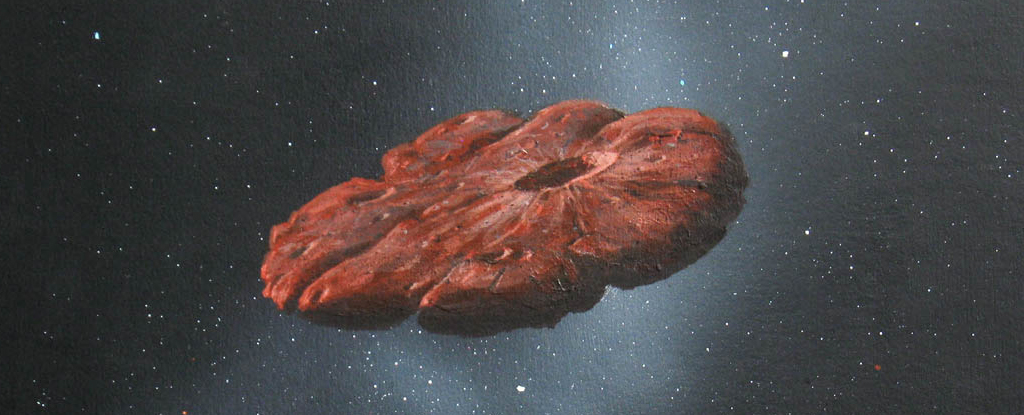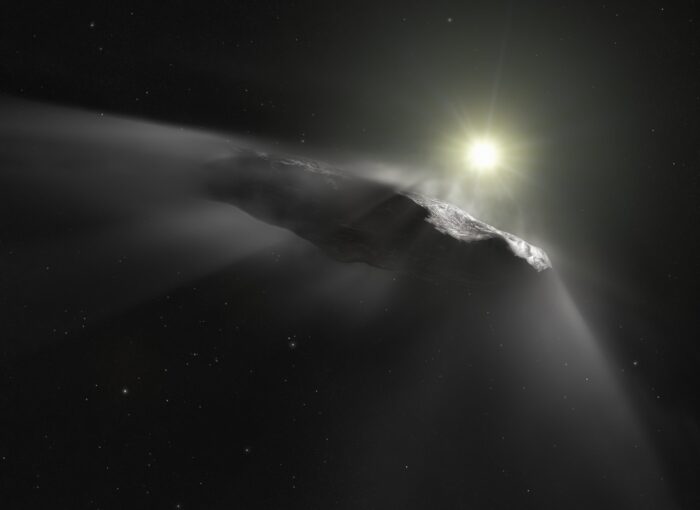What if the inception of life on Earth occurred due to the collision of interstellar objects?
On October 19th, 2017, astronomers from the Pan-STARRS survey made a groundbreaking discovery. They detected an interstellar object (ISO) passing through our Solar System for the very first time. This object, named 1I/2017 U1 Oumuamua, sparked intense scientific debate and remains a topic of controversy to this day.
However, one point of agreement among scientists is that the detection of this object provided evidence that ISOs regularly enter our Solar System. Furthermore, subsequent research has shown that some of these objects have actually reached Earth as meteorites, impacting its surface.This discovery raises a crucial question: if ISOs have been arriving on Earth for billions of years, is it possible that they have brought the building blocks of life with them?
In a recent scientific paper, a team of researchers explored the implications of ISOs being responsible for panspermia. Panspermia is a theory that suggests the existence of life’s seeds throughout the Universe, which are distributed by asteroids, comets, and other celestial bodies.According to the team’s findings, ISOs have the potential to seed hundreds of thousands, or even billions, of Earth-like planets within the Milky Way galaxy.

The research team was led by David Cao, a senior student at Thomas Jefferson High School for Science and Technology (TJSST). Joining him were Peter Plavchan, an associate professor of physics and astronomy at George Mason University (GMU) and the Director of the Mason Observatories, as well as Michael Summers, a professor of astrophysics and planetary science at GMU.Their paper, titled “The Implications of ‘Oumuamua on Panspermia,” was recently published online and is currently undergoing review for publication by the American Astronomical Society (AAS).
In summary, panspermia proposes that life on Earth originated from interstellar objects in the vastness of space. These objects may have carried extremophile bacteria capable of surviving the harsh conditions of the interstellar medium (ISM).
The distribution of life throughout the universe occurs through a process known as panspermia. This process involves objects passing through the interstellar medium (ISM) until they eventually reach and impact potentially habitable planets. Panspermia sets itself apart from other theories, such as abiogenesis (the RNA World Hypothesis), which explain the origins of life on Earth. According to the RNA World Hypothesis, RNA preceded DNA and proteins in the evolutionary process, ultimately leading to the emergence of life on our planet.
However, assessing the plausibility of panspermia is a challenging task, as pointed out by Cao in an email to Universe Today. Panspermia involves numerous factors that need to be taken into account, many of which are not well understood or constrained. For example, the physics behind panspermia, such as the number of objects that collided with Earth before the earliest evidence of fossilized life, and the biological factors, like the ability of extremophiles to withstand supernova gamma radiation, are still uncertain.
Furthermore, there are unanswered questions and limitations in our ability to effectively model certain aspects of panspermia. For instance, even if a life-bearing object collided with Earth, we do not know the exact number of extremophiles that would actually reach our planet, nor do we fully understand the probability of life starting from these foreign extremophiles. Additionally, factors like the changing rate of star formation and the recent discovery of rogue free-floating planets further complicate the assessment of panspermia.
Therefore, due to the multitude of factors involved and the ongoing advancements in our understanding of these factors, the plausibility of panspermia remains a constantly evolving subject.

The discovery of ‘Oumuamua in 2017 marked a significant milestone in the field of astronomy, representing the first observation of an interstellar object (ISO). Its detection indicated the statistical significance of such objects in the vast expanse of the Universe and suggested that ISOs regularly traverse the Solar System, with some potentially still present.Two years later, another ISO named 2I/Borisov entered the Solar System, but unlike its predecessor, there was no ambiguity regarding its nature. As 2I/Borisov approached the Sun, it developed a tail, clearly indicating its cometary nature.
Further investigations have revealed that some of these ISOs transform into meteorites that collide with the Earth’s surface, and a few have even been identified. One such example is CNEOS 2014-01-08, a meteor that impacted the Pacific Ocean in 2014 and was extensively studied by the Galileo Project.The detection of these interstellar visitors also holds implications for the concept of panspermia and the ongoing debate surrounding the origins of life on Earth. According to Cao, the physical characteristics of ‘Oumuamua provide valuable data for panspermia models. By analyzing its mass, size, and implied number density within the interstellar medium, we can estimate the density and mass of objects present in this medium. These models enable us to approximate the flux density and mass flux of interstellar objects and, consequently, estimate the total number of objects that have impacted Earth over a span of 0.8 billion years, which is the hypothesized timeframe between Earth’s formation and the earliest evidence of life.
Understanding the total number of collision events during this period is crucial for evaluating the plausibility of panspermia. A higher frequency of collisions with interstellar objects would suggest a greater likelihood of panspermia.
In summary, the physical properties of the interstellar ISO ‘Oumuamua provide a foundation for mathematical models that assess the feasibility of panspermia.
Furthermore, Cao and his colleagues incorporated a biological model into their research, in addition to the mathematical models that consider the physics behind panspermia. This biological model focuses on determining the minimum object size required to protect extremophiles from various astrophysical events such as supernovae, gamma-ray bursts, large asteroid impacts, and passing-by stars.As previously discussed, recent studies have revealed that cosmic rays erode all but the largest Interstellar Objects (ISOs) before they can reach another system.
These additional considerations have a significant impact on the number of objects that could potentially impact Earth, excluding those that have been sterilized by astrophysical sources. They also influence the plausibility of panspermia.Cao explained, “To determine the minimum object size, we utilized various models, including the sphere packing method, which provided a rough estimate of the distance between an ejecta and the nearest supernova progenitor. We used Orion A, a dense star cluster, as our model. Additionally, we considered the gamma radiation that reaches the ejecta and the attenuation coefficient, which indicates how much radiation the ejecta absorbs. These calculations were based on the most probable chemical composition of the ejecta, specifically water ice.”
By combining their physical and biological models, the research team was able to estimate the number of ejecta that impacted Earth prior to the emergence of life. According to the oldest fossilized evidence found in western Australia, dating back to the Archaean Eon, life forms emerged approximately 3.5 billion years ago. Cao stated,
The probability of panspermia sparking life on Earth is estimated to be around 0.001 percent or 10-5. Despite this seemingly low probability, there could potentially be 4×109 habitable exoplanets within the habitable zone of our Galaxy, suggesting the existence of around 104 habitable worlds that could support life.Furthermore, our analysis focused on the first 0.8 billion years of Earth’s history, before the earliest evidence of fossilized life. However, since life can be seeded at any point in a planet’s lifespan and habitable lifespans can extend up to 5-10 billion years, we increased our estimate for the total number of habitable worlds in our Galaxy by one order of magnitude.
As a result, Cao and his colleagues determined that there are approximately 105 habitable planets in our galaxy that could potentially harbor life. It is important to note that these estimates are based on the most optimistic assumptions regarding planetary habitability.In simpler terms, these estimates assume that all Earth-sized rocky planets within habitable zones have the necessary conditions to support life, including thick atmospheres, magnetic fields, liquid water on their surfaces, and the ability for life-bearing particles to survive entry into our atmosphere and deposit microbes on the planet’s surface.
Cao’s summary highlights that their results do not definitively prove the concept of panspermia or settle the ongoing debate surrounding the origins of life on Earth. Nonetheless, these findings offer valuable insights and limitations regarding the possibility of life being transported to Earth through objects like ‘Oumuamua.Regardless of the outcome, these discoveries are expected to have significant implications for the field of astrobiology, which is progressively becoming more diverse:
“Astrobiology encompasses the integration of physics, biology, and chemistry in the study of panspermia as a potential source of life. It is uncommon to find such a wide range of topics within a single research area. I believe that the interdisciplinary nature of astrobiology is a positive trend, as it allows experts from various backgrounds to contribute to the advancement of this field.”Our research may contribute to this trend. While our findings suggest that the likelihood of panspermia initiating life on Earth is low, the number of planets within the habitable zone of our Galaxy that may harbor life is considerably higher.
“Future studies in astrobiology can utilize these findings to further explore the concept of panspermia. However, it is important to acknowledge that we have not accounted for all possible factors that could influence the plausibility of panspermia.”I believe that our findings present new avenues for future research on panspermia, whether it involves updating our models or considering additional factors.”One potential area of investigation, if we do discover evidence of life on other celestial bodies in the future, whether within our Solar System or through the detection of biosignatures in exoplanet atmospheres, is to conduct experimental and observational tests to differentiate between life that arrived via panspermia and life that independently evolved and originated.”
This article is republished from sciencealert under a Creative Commons license. Read the original article.
Do not forget to share your opinion with us to provide you with the best posts !




0 Comments